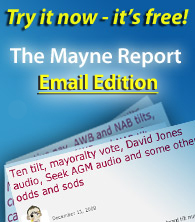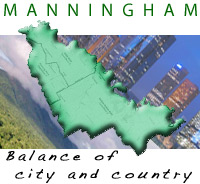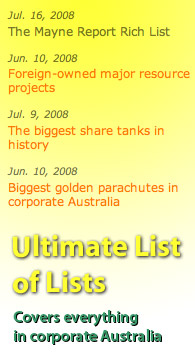Macquarie on Allstate, Aristocrat Leisure and what directors get
July 22, 2008
Here are Stephen Mayne's three stories from the Crikey edition on Wednesday, 3 May, 2006.
7. What Macquarie told Allstate creditors in 2002
By Stephen Mayne
More documents about Macquarie Bank's role at the Beaconsfield
Gold Mine have reached the Crikey bunker, so today we can explain the circumstances in which creditors voted to give the financial powerhouse the right to recover a $54 million loan they never lent – for just $300,000.
Click here to see an extract from the March 2002 creditors report to mine operator and controlling shareholder Allstate Exploration (in administration) as these capture some of the crucial action from the meeting which voted to give the Millionaire Factory their bonanza.
Dale Elphinstone of William Adams asked the following question at the meeting: What is Macquarie Bank's view to going forward if this proposal is not approved?
The minutes record Macquarie Bank executive Warrick Morris as follows:
To date MBL have been very supportive of the mine. For example they are currently contributing towards capital development of the mine. Mr Morris outlined that the Bank had other options if the proposal is not approved. Firstly, MBL can sell the property and then liquidate the companies. Secondly, MBL may not continue with capital development and mine and process what ore is currently available and then let the mine flood. Thirdly, it could carry on as in the current structure. Mr Morris noted that if the proposal were not accepted, it would be difficult to commit to the Bank continuing to support the mine over the next five years.After hearing that and listening to the advice of administrator Michael Ryan, creditors voted to give Macquarie what was looking likely to become one of its greatest ever windfalls before last week's tragic rockfall.
The Australian's Michael West has been fighting Macquarie ever since the paper copped a NSW Supreme Court writ over his coverage of this story last year. Today West produced this page one story pointing out that the parents of trapped miner Todd Russell, are one of the Allstate creditors who have only recovered 83c in the dollar whilst Macquarie has recovered its original $21 million loan, all outstanding interest, plus $3.3 million on the $54 million inter-company loan that it never lent.
It would be interesting to hear from administrator Michael Ryan at today's Allstate creditors meeting in Launceston about the cash reserves he's currently sitting on. If the mine never reopens, Macquarie and Ryan will have some extremely sensitive decisions to make about compensation, creditors, worker entitlements, redundancy pay and what happens to those cash reserves, given that the Millionaires Factory is at the front of the queue and is already well in profit, especially when you consider the hedge book.
23. Aristocrat Leisure – Australia's most inaccurate balance sheet
By Stephen Mayne
Did you hear the one about the company which produced an audited balance sheet declaring it had net assets of $351 million when the market valued the stock at $7 billion? Meet global pokies giant Aristocrat Leisure, which had a two-hour annual meeting at Star City Casino yesterday.
The Australian touched on the debate today:
Shareholder activist Stephen Mayne asked at the AGM why the company had a market capitalisation of $7 billion but only reported net cash assets of $350 million. Chairman David Simpson replied that the market capitalisation of Aristocrat was dictated by the market while the net cash assets had been worked out according to the new international accounting standards.Net cash assets are actually $183 million, and we're talking a company declaring its total worth is just $351 million – something PwC auditor Ross Gavin signed off on as "a true and fair view" and "free of material mis-statement".
Cranky Aristocrat chairman David Simpson was right to point to the historical basis of accounting standards. But I then fixed him right up by asking this follow-up question:
Corporate Australia has a long tradition of new CEOs coming in and announcing big write-downs that paint the previous guy black and make him look much better in the future. Witness Malcolm Broomhead at North, Don Mercer at ANZ, Paul Anderson at BHP and Peter Smedley at Mayne. Therefore, in light of the current $7 billion market capitalisation and $351 million in claimed net assets, why on earth did the Aristocrat board and auditor allow its new CEO to write down the company's assets by $160 million to just $218.6 million in 2003 – a year when it had positive cash flow of $200 million and was valued by the market at a couple of billion?The best Simpson could do was to say we were discussing the 2005 accounts.
Earlier in the meeting the Aristocrat finance director said he was delighted S&P had yesterday lifted its credit rating to BBB-.
When I pointed out that a company that returned $300 million to shareholders last year and generated free cash of $360 million should have a much higher credit rating, chairman Simpson opined that S&P was "very, very conservative indeed".
Which is precisely my point. Why produce a balance sheet that massively understates your worth if it means you're left with a lower credit rating and higher cost of funds?
Why? Well, sin industry companies have long had a tradition of understating their worth because they don't want regulators or victims of their products (ie problem gamblers) to cotton on to the scale of their bonanza. Back to Top
24. What directors get in takeovers
By Stephen Mayne
The Australian's Strewth column and The AFR's Rear Window column both picked up the exchange from the SFE Corp AGM in Sydney yesterday about whether the non-executive directors would be getting any sort of pay rise or bonus out of the $2.2 billion agreed ASX takeover.
While we all had a good joke about the SFE directors being underpaid and chairman Rick Holliday-Smith declaring they would get nothing extra apart from a good dinner, there is a serious issue here that has never been properly discussed in the mainstream media.
The famous advice from Mark "Deep Throat" Felt in Watergate was to "follow the money" and that is something which should also happen in takeovers. In the case of SFE, the non-executive directors are underpaid relative to its peers, so I asked whether the NEDs would utilise the full $1 million cap for the seven months of work they'll do before ASX takes control. It seems not.
Given the value they have created, few shareholders would begrudge such a move but it would never be disclosed to shareholders because there won't be a 2006 SFE Corp annual report.
The worst example of abuse that I'm aware of was the 2000 takeover of Australian Hospital Care by Mayne Nickless. Chairman Lawrie Willett activated a director retirement scheme after the takeover was sealed and this cost Mayne Nickless shareholders an extra $300,000, as each director got an additional lump sum equivalent to three years' pay. This was never disclosed and I only know because a board insider fessed up a couple of years ago.
Another interesting example was the 1996 creation of Rio Tinto as a dual-listed company. Melbourne-based CRA ended up being subsumed into London-based Rio but the old CRA chairman, John Uhrig, made almost $2 million out of the deal because his pay as co-chairman had to match that of the Rio chairman and suddenly he was getting $500,000 a year.
Unlike Australian Hospital Care, at least the Rio Tinto payments were publicly disclosed, although shareholders usually aren't told of the plan at the time they are voting on the deal.
Then you have the old consultant trick, something that was used by HIH to pay Rodney Adler millions more after he signed off on the ill-fated FAI takeover.
The other great board and management financial motivator in takeovers is the "change of control" clause in option and equity incentive schemes. In the case of SFE CEO Robert Elstone, he was issued 1 million options at $8.03 on 2 May last year but these were only valued at $530,370 in the annual report, so claims that his package was only worth $1.88 million in 2005 are clearly inaccurate.
Elstone presumably now won't have to wait four years and leap all sorts of performance hurdles to exercise the options, thanks to the ASX takeover. With SFE Corp shares closing at $15.91 yesterday, he stands to make almost $7 million on his four-year options in just 14 months. After six years as CEO and with plum board seats such as NAB (not CBA as The AFR reported today) and the Future Fund, Elstone's decision to retire with a windfall is perhaps easier to understand.
It's a different story for the non-executive SFE Corp directors, who collectively only own about 76,000 shares worth $1.2 million. Chairman Rick Holliday-Smith is clearly underpaid with his $175,000 package, especially when you compare it with the $287,500 that Alumina chairman Don Morley will collect this year for leading a post-box company that doesn't do much.
However, he and two other SFE directors will continue to get fees from their seats on the ASX board, while the rest of the underpaid directors won't get much more than that nice dinner.
Next time a board recommends a takeover, ask yourself whether the directors will be better or worse off as a result. When Lend Lease wanted to take over GPT in 2004-05, the GPT board stood to lose out. By instead ditching Lend Lease and jumping into bed with Babcock & Brown, chairman Peter Joseph has enjoyed a pay rise from $120,000 to $300,000 a year. Nice.
Copyright © 2024 The Mayne Report. All rights reserved






















